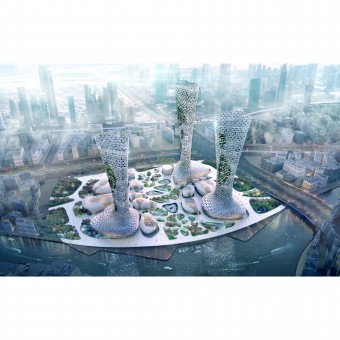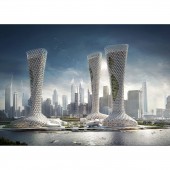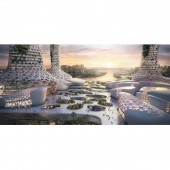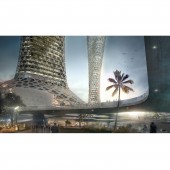
| THE AWARD |
| CATEGORIES |
| REGISTRATION |
| SUBMIT YOUR WORK |
| ENTRY INSTRUCTIONS |
| TERMS & CONDITIONS |
| PUBLICATIONS |
| DATES & FEES |
| METHODOLOGY |
| CONTACT |
| WINNERS |
| PRESS ROOM |
| GET INVOLVED |
| DESIGN PRIZE |
| DESIGN STORE |
| THE AWARD | JURY | CATEGORIES | REGISTRATION | PRESS | WINNERS | PUBLICATIONS | ENTRY INSTRUCTIONS |
Symbiotic Mixed Use Development by Zayad Motlib |
Home > Winners > Design #61345 >Interview |
 |
|
FS: What is the main principle, idea and inspiration behind your design?
ZM: The main idea was to design with environmental sensibility, that is to have the environmental data informing the generation of the Towers’ forms and skins. The plaza planning concept was inspired by the formation of a desert oasis and a voronoi pattern as found in natural systems. The aim was to create a plaza with a landscape that people can use throughout the year.
FS: What has been your main focus in designing this work? Especially what did you want to achieve?
ZM: The proposal seeks to integrate contextual environmental data of Dubai into a synthesis of forms, skins, and public spaces. We wanted to create public spaces which people can enjoy and use throughout the year. And private spaces that have best views, yet limited glare or radiation that cause discomfort inside and demand high load of the cooling system. Buildings Performance on the social, environmental, and functional levels were a key objective of the development.
FS: What are your future plans for this award winning design?
ZM: We will keep developing all the tectonic and engineering details for its construction. I am currently developing ideas for the external skin, studying ways to construct it, and integrating multiple systems in it that would enhance its performance.
FS: How long did it take you to design this particular concept?
ZM: About two months. I was researching and developing different ideas with the same core design principles.
FS: Why did you design this particular concept? Was this design commissioned or did you decide to pursuit an inspiration?
ZM: I developed it for a particular site in Dubai as an alternative design to a concept that has been done by a corporate office in Dubai on the same site, using the same program, site restrictions, and area requirements. We wanted to show the developer a different way of thinking than the typical glass boxes towers that have been developed everywhere. I wanted to show them different possibilities that can lead to a design with better aesthetics, environmental sensibility, and lower running cost.
FS: Is your design being produced or used by another company, or do you plan to sell or lease the production rights or do you intent to produce your work yourself?
ZM: I am planning to keep developing it at my studio. We are planning to start liaising with an engineering team to develop it to a construction stage.
FS: What made you design this particular type of work?
ZM: Living in Dubai over the last 8 years. The place has an extreme weather condition with temperature rises in summer to about 50’C. However, most of the high-rise developments that have been built over the last 15 years were glass boxes that have no connection to the context of Dubai. These towers are subjected to massive amount of radiation in summer, which require huge air-cooling load to make them habitable. I was looking for new typology of buildings that provide better working and living environment inside, and reduces the reliance on the prevailing air-conditioning system. I wanted the architecture to exist in symbiosis with the natural environment of Dubai.
FS: Where there any other designs and/or designers that helped the influence the design of your work?
ZM: No there were not.
FS: Who is the target customer for his design?
ZM: The developer.
FS: What sets this design apart from other similar or resembling concepts?
ZM: Generally, Most of Dubai buildings address sustainability as a post design optimization; an engineering solution in the form of louvers, or other add-ons, to the building form to enhance its environmental performance. In this project, sustainability has been addressed as a concept driver, rather than an engineering practice that often takes place later on during the design development.
FS: How did you come up with the name for this design? What does it mean?
ZM: The design aims to achieve co-existence with the natural environment of Dubai, to have a symbiotic relationship, and hence came the name of The Symbiotic Towers.
FS: Which design tools did you use when you were working on this project?
ZM: The project has been developed using a hybrid process that integrates a combination of parametric data-based system with an analogue process. The different tools and techniques have been deployed to achieve a human-centered sustainable and performance-based design. We used a variety of media ranging from sketches to computer models to 3d printing. However, the main tool was the use of parametric visual scripting with grasshopper. Towers’ geometry and skins were developed in response to Dubai climatic conditions. Radiation data of the hottest seasons in Dubai (May-October) were mapped into the geometry and used to shape the form and orientation of each tower. Towers geometry taper and twist so as to reduce the surface area that is exposed to high radiation. These data were also re-mapped to generate parametric gradient balconies depth and skin openings. The apartments that are exposed to high radiation will have deeper balconies, while the apartments that are exposed to less radiation will have shallower balconies. Skin openings were also generated with differentiated opening sizes based on the radiation values. The part of the skin that is exposed to high radiation will have smaller openings, while the side that is exposed to less radiation will have bigger openings. Parametric tools have also been incorporated to optimize building performance. They have been used to minimize direct sun and glare on each floor, and to maximize views and connection with the outside. Continuous negotiations between these parameters, and the program for each tower, have been directed to reach a synthesis between program, geometry, and performance.
FS: What is the most unique aspect of your design?
ZM: The project creates its own ecology. It provides a variety of outdoor and indoor spaces which can be used throughout the year. It consists of a residential, a hotel, and an office tower, connected on the ground level by a double-deck pedestrian shopping plaza. The connecting plaza creates two environments that can be used throughout the different seasons. The first environment, the lower deck, is a lavish green semi-shaded oasis level that is packed with trees and water to provide gathering zones for people during the hot summer season. It is located on the natural landscape level to be accessible to pedestrians from all sides. The second environment is a stretched voronoi perforated deck that gently ramps up from both ends of the site to form an elevated upper plaza that is simultaneously connected with the lower level oasis via many ramps. This plaza is partially shaded by trees extending through the voronoi openings. Also, photovoltaic umbrellas have been placed on tree-like structures in some of these openings. They collect the sun energy and convert it into power to feed the cross-ventilation system of the oasis level. This treatment, along with the shading provided by the upper deck level and the dense plantation, create a micro-climatic habitable environment that can be used during the hottest seasons in Dubai. The shopping plaza design departs from the traditional homogenous shopping spaces of Dubai malls, into smaller buildings of different sizes scattered within the overall voronoi pattern of the plaza. Their placement creates spaces of different scale and nature. They invite people to navigate the plaza in a way finding manner as they meander among these spaces, and therefore enjoy a more engaging and interactive shopping experience.
FS: Who did you collaborate with for this design? Did you work with people with technical / specialized skills?
ZM: At this stage no. But we will need people with technical skills to collaborate with to develop the project design, materiality, and construction methods for the next stages.
FS: What is the role of technology in this particular design?
ZM: Technology has been an integral part of the design and the construction process. For the design, we used visual scripting software to accurately calculate the radiation data on the skin during the hottest period in Dubai, then used these data to inform the form and skin generation. For the construction, technology will be used for the 3d printing and the passive cooling system of the skin. Construction details will be developed in the next stage.
FS: Is your design influenced by data or analytical research in any way? What kind of research did you conduct for making this design?
ZM: As the design was based on environmental data, we conducted a thorough research on the environmental data in Dubai, as well as at the natural desert oasis formation to create a micro climate that can be used throughout the year on the lower deck level.
FS: What are some of the challenges you faced during the design/realization of your concept?
ZM: From the beginning we had a clear concept and design objectives. The design was developed based on an on-going negotiation between the technical weather data, the programmatic requirements, and our aesthetic sensibility for the from and skin generation. Blending these data and be able to produce an environmentally and aesthetically sensible design that is responding the different programmatic requirements was our core challenge in the development.
FS: How did you decide to submit your design to an international design competition?
ZM: I believed the design has strong merits, and an innovative approach that is new to its context. It proposes new form of buildings and design thinking that can positively contribute to Dubai architecture and its environment.
FS: What did you learn or how did you improve yourself during the designing of this work?
ZM: The design was an intense journey with lots of uncertainties. We were not working with an existing model, we were trying to create something new. We knew what we wanted to achieve. But the methodology and the path ahead was not clear for us. It took lots of experimentations, trial and error, to get the result we were aspiring for. In this journey, we developed sensibility to weather data and how to use them to positively inform design decisions at an early design stage. Additionally, we developed the knowledge and the techniques that we can apply to future developments of any kind or scale of buildings. We will adopt this informed process as our new workflow, as it will define who we are and the architectural principles we stand for. And we have already started doing this.
FS: Thank you for providing us with this opportunity to interview you.
A' Design Award and Competitions grants rights to press members and bloggers to use parts of this interview. This interview is provided as it is; DesignPRWire and A' Design Award and Competitions cannot be held responsible for the answers given by participating designers.
| SOCIAL |
| + Add to Likes / Favorites | Send to My Email | Comment | View Press-Release |




